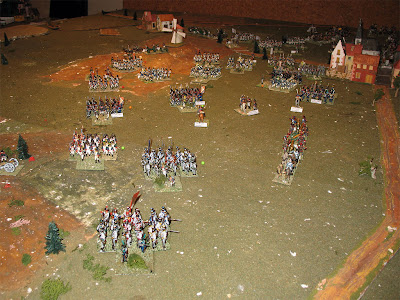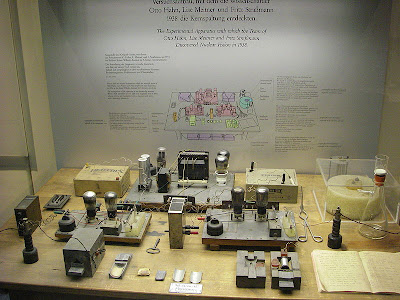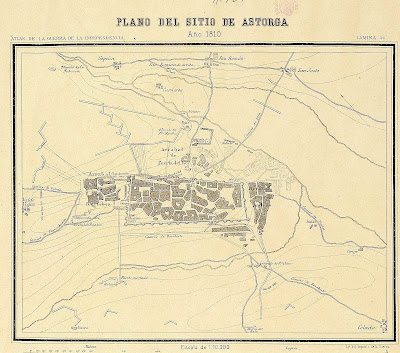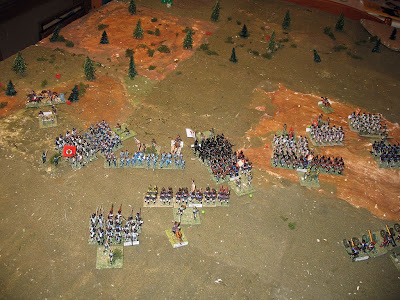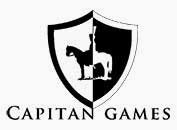The Hagelberg AAR
At last I wrote the after action report (AAR) for the refight of Hagelberg using Lasalle. It can be viewed in the main site Battle of Hagelberg
The Scenario is bigger than a typical Lasalle combat, but it runned smoothly since the battle can be considered as composed by three different, and almost independent combats, fought respectively in the flanks and central section of the battlefield.
The combat in the French left flank was almost equilibrated in numbers. Four French and two Westphalian batallions were fronted by seven Prussian batallions, one cavalry squadron and one howitzer. Four of the seven Prussian infantry units were Landwehr, i.e. unpredictable units, which after the first combat resulted 'Shaky' so the overall quality of both sides was similar, with a slight advantage for the Allied (4 vs. 3 'Reliable' units). The Allied also counted during the first movements of the battle with the help of a full French foot battery, deployed in their right flank on a hill.
 The fight in this sector was very fierce, and finished with the Prussian rout. The Prussian losses were four infantry batallions and the cavalry squadron. The French only suffered one infantry batallion broken, and they were allowed to leave the battlefield almost unmolested. Additionally, their succesful fight also allowed an easy retreat for all the French baggage train and the two full artillery complement (two batteries).
The fight in this sector was very fierce, and finished with the Prussian rout. The Prussian losses were four infantry batallions and the cavalry squadron. The French only suffered one infantry batallion broken, and they were allowed to leave the battlefield almost unmolested. Additionally, their succesful fight also allowed an easy retreat for all the French baggage train and the two full artillery complement (two batteries).In the central section the fight was different. Girard (French C-i-C) had devised an in-depth defence, with a Croat batallion garrisoning a lone farm covering the only bridge, and also placed light infantry to dispute the Prussian cross of the stream.
However, the Prussian numerical superiority in this sector resulted in a complete Allied rout: five of their six Infantry batallions where broken, by none of the Prussians! The fighting retreat devised by Girard reasulted actually in an aniquilation battle. One of the Prussian Landwehr units, the 3/6th Kurkmark Landwehr was the 'heroic unit of the day' decisively contribution to the break of the Allied line (their unpredictable esprit transformed they into a 'Valiant' unit in the first combat).
 The fight in the French right flank was a typical cavalry combat with a continuous ebb and flow. Units were winning and losing combats. The French had quality advantage over the Prussians ('Reliable' vs. 'Shaky' units) and finally managed to extricate, just in time, their Hussars and Chasseurs through the town of Hagelberg.
The fight in the French right flank was a typical cavalry combat with a continuous ebb and flow. Units were winning and losing combats. The French had quality advantage over the Prussians ('Reliable' vs. 'Shaky' units) and finally managed to extricate, just in time, their Hussars and Chasseurs through the town of Hagelberg. Due to the congested state of the battlefield, none of the C-i-C's and especially von Hirschfield, the Prussian General, made good use of his artillery: only one French battery was used although was almost inmediately limbered to avoid its capture.
Due to the congested state of the battlefield, none of the C-i-C's and especially von Hirschfield, the Prussian General, made good use of his artillery: only one French battery was used although was almost inmediately limbered to avoid its capture.Summarizing, the battle was a very interesting and enjoyable game. The battle concluded with the Allied (French and minor German) rout like in the real world. Their losses amounted to a 42% of their initial force, although they retained their full material (guns and baggage).
Lasalle is a good rule-set. I'll use it in the future to play minor engagements, that can be not well covered by Napoleon's Battles.
Remember you can access to more pictures at Battle of Hagelberg in the main web site.
